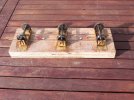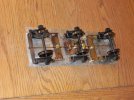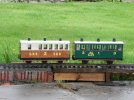Here's my first experimental vehicle. It is good on good, level track - goes round all the bends no problem (and that includes a couple of bits of 1175mm radius). But it does not have enough compensation to cope with wobbly bits of track. My solution will be to relay the wobbly bits of track on proper foundations where at present it's just on hard=packed earth and subject to weed invasion, and weathering. It's a job I should have done years ago.I have found curve to be the worse area for derailment, especially if the wagon does not have compensation. If hand push the wagon around the curve, check to see if all 4 wheels remain in contact with the rail, a bit of hand "wobbling" as you push it around, you may find a spot where the flange just clears the top of the rail, and this is you issue. The wheel base, axle compensation, flange size and position in the rake will all help determine if a wagon derails.
The brass rods which join the outer ponies to the swivel joints, and the ones which pass right through all three trucks are Sifbronze brazing rods. These have just the right degree of springiness to allow the trucks to align themselves radially with the curves without putting too much side force on the flanges.
Thanks for all your suggestions.



